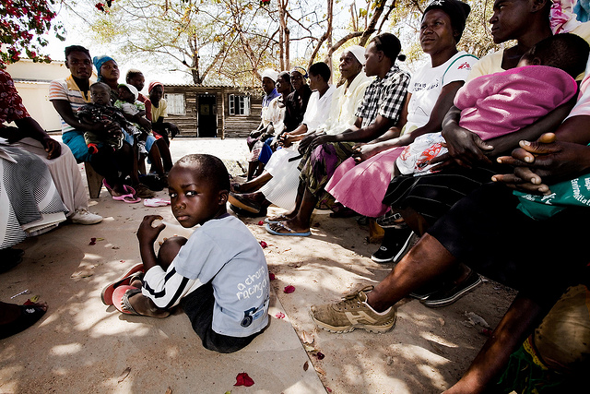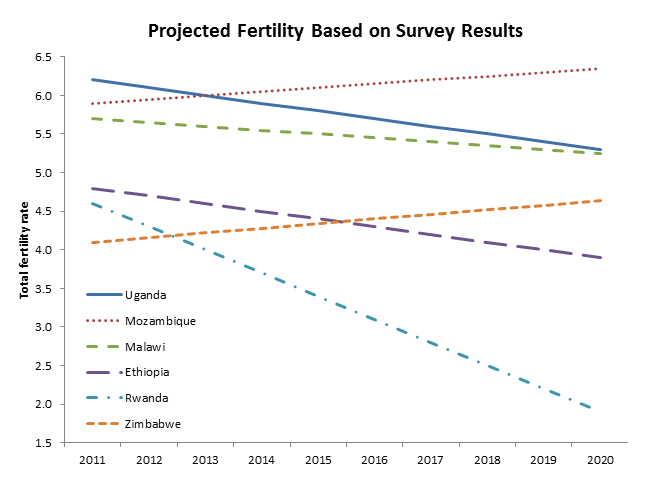-
New Surveys Generate Mixed Demographic Signals for East and Southern Africa
May 8, 2012 By Elizabeth Leahy Madsen
The pace of fertility decline in sub-Saharan Africa will be the single most important factor in whether the global population reaches the UN’s high projection of nearly 11 billion in 2050, or remains closer to the low projection of 8 billion. In recent years, the high projection has seemed more likely, as sub-Saharan Africa has been marked by stalled fertility declines and stagnant rates of contraceptive use. Survey results released over the past year showing dramatic increases in contraceptive use in Ethiopia, Malawi, and Rwanda therefore set demographers and the family planning community abuzz, signaling that concerted efforts to improve health services had paid off and fertility rates were on the decline. But in recent months, additional surveys from Mozambique, Uganda, and Zimbabwe have shown that those positive trends are not universal.
A Trio of Emerging Success Stories
For many countries in sub-Saharan Africa, rapidly growing populations concentrated among youthful ages are outpacing improvements in quality of life and testing governments’ capacities to provide basic health services, education, and jobs. For the region as a whole, the contraceptive prevalence rate (CPR) for modern methods increased by just 0.3 percentage points per year between 2000 and 2009, following similarly sluggish annual increases in the previous two decades.
At this growth rate, more than a century would pass before sub-Saharan Africa, which had an average CPR of less than 16 percent in 2009, achieves the same levels of contraceptive use seen today in North Africa.
Given this regional context, the release of three successive surveys showing rapid jumps in CPR was noteworthy. In Ethiopia, the percentage of married women using a modern contraceptive method jumped from just 6 percent in 2000 to 27 percent in 2011. Malawi, starting from a higher baseline, experienced an increase from 26 percent in 2000 to 42 percent in 2010. Both countries’ CPR rose at a pace of more than two percentage points per year, about seven times faster than the regional average. However, the changes reported in Rwanda were undoubtedly the most dramatic. Contraceptive use more than tripled in just five years, growing by seven percentage points annually. In turn, fertility fell by 25 percent, from 6.1 to 4.6 children per woman in just five years.
Fertility Rises Elsewhere
In March, demographic surveys carried out by MEASURE DHS and funded by USAID were published for Mozambique, Uganda and Zimbabwe (the available reports for Mozambique and Uganda are based on preliminary findings). While one of these countries had an increase in contraceptive use, the other two recorded showed no progress.
Uganda, which has one of the highest fertility rates and youngest populations in the world, experienced an uptick in contraceptive use, from a rate of 18 percent for modern methods in 2006 to 26 percent in 2011. Although not at the pace seen in Ethiopia, Malawi, or Rwanda, the average growth of 1.6 percentage points annually was above the regional average. Its fertility rate declined from 6.7 to 6.2 children per woman.
More disheartening is the very unusual finding that fertility rates are increasing and contraceptive use is stagnant in both Mozambique and Zimbabwe. Over the past 15 years, CPR has increased slightly and since plateaued in Mozambique, while fertility has continued to rise. Between 1997 and 2003, contraceptive use jumped from 5 to 12 percent, where it remained in 2011. Meanwhile, fertility has risen from 5.5 to 5.9 children per woman since 2003.
Zimbabwe is one of the few countries in sub-Saharan Africa where more than half of married women use a modern contraceptive method, but the rate has dipped slightly, from 58 to 57 percent over five years. More surprising is the increase in the fertility rate, from 3.8 to 4.1 children per woman. Fertility among the youngest mothers, ages 15 to 19, is higher today than in the late 1980s and early 1990s.
Population Possibilities
The central characteristic of population trends today at the global level is their diversity. Some countries in East Asia and Europe are reaching unprecedented low fertility rates, near one child per woman, and many developing countries are nearing the later stages of the demographic transition, with family sizes around two or three children per woman. Yet most countries in sub-Saharan Africa have not followed the pattern of steady fertility decline. Do the mixed results from these recent surveys indicate that demographic diversity is becoming the norm within Africa too?
Although there is tremendous variance at the country level, on average, fertility declines by one child per woman for every 15 percentage point increase in contraceptive use. However, fertility changes have multiple determinants and the effect of changing contraceptive use is not immediate. In Malawi especially, the fertility rate remains relatively high given that contraceptive use has surpassed 40 percent, a puzzle that will be explored at a national family planning conference hosted by the government and several international partners this month.
Although it is unlikely that current trends will hold exactly, the figure below shows results if the most recent changes in fertility are projected forward at a steady rate. Most countries’ fertility rates would change by less than one child per woman over the next decade and all but Rwanda would remain at or above four children per woman.
The recent changes in contraceptive use therefore suggest that progress through the demographic transition will remain fairly slow in these countries. Populations will continue to grow rapidly and remain very youthful, and continued investments in family planning are necessary in order to promote the potential social and economic benefits of a more balanced age structure.
Lessons From Neighbors
The factors promoting success in the three countries where the pace of family planning use is ramping up have been carefully analyzed.
In Ethiopia, Mengistu Asnake of Pathfinder International attributes success to the government’s commitment to improve access to services in rural areas by constructing 15,000 health posts and training community members as health extension workers. The World Health Organization has identified the policy empowering local health workers to distribute injectable contraceptives, a popular method, as key to Malawi’s success. And Rwanda’s rapid growth in contraceptive use has been linked to tangible support from policymakers at the highest levels and the introduction of community-based insurance networks, as well as plentiful funding.
The divergent trends found in these six surveys are an important reminder that demographic trends do not operate in a vacuum. Countries do not progress through the demographic transition or achieve the demographic dividend at a predetermined pace. The policy environment, culture, and socioeconomic factors have tremendous influence on health outcomes and the behavioral determinants of fertility change.
If leaders in Mozambique, Uganda, Zimbabwe, or other countries wish to alter their current trajectories, the emerging successes of family planning programs in Ethiopia, Malawi, and Rwanda prove the tremendous impact of political support and intensive expansion of services to underserved areas and people.
Note: The figures reported for contraceptive use in Mozambique vary between StatCompiler and the DHS reports, and have been updated based on clarifying information received by the author. StatCompiler was used for all other fertility and contraceptive prevalence rates, except those not yet included in StatCompiler, in which case data was drawn from the relevant final DHS report (preliminary reports for Mozambique and Uganda).
Elizabeth Leahy Madsen is a consultant on political demography for the Wilson Center’s Environmental Change and Security Program and senior technical advisor at Futures Group.
Sources: Asnake (2011), Bongaarts (2008), Leahy Madsen (2011), Mack (2012), MEASURE DHS, Solo (2008), Tsui (2011 and 2001), United Nations Population Division, USAID, WHO.
Image Credit: “Psychosocial support group in Zimbabwe,” courtesy of U.K. Department for International Development. Chart Credit: Elizabeth Leahy Madsen.
Topics: Africa, demography, development, Ethiopia, family planning, global health, Malawi, Mozambique, population, Uganda, USAID, Zimbabwe
 A Publication of the Stimson Center.
A Publication of the Stimson Center.






